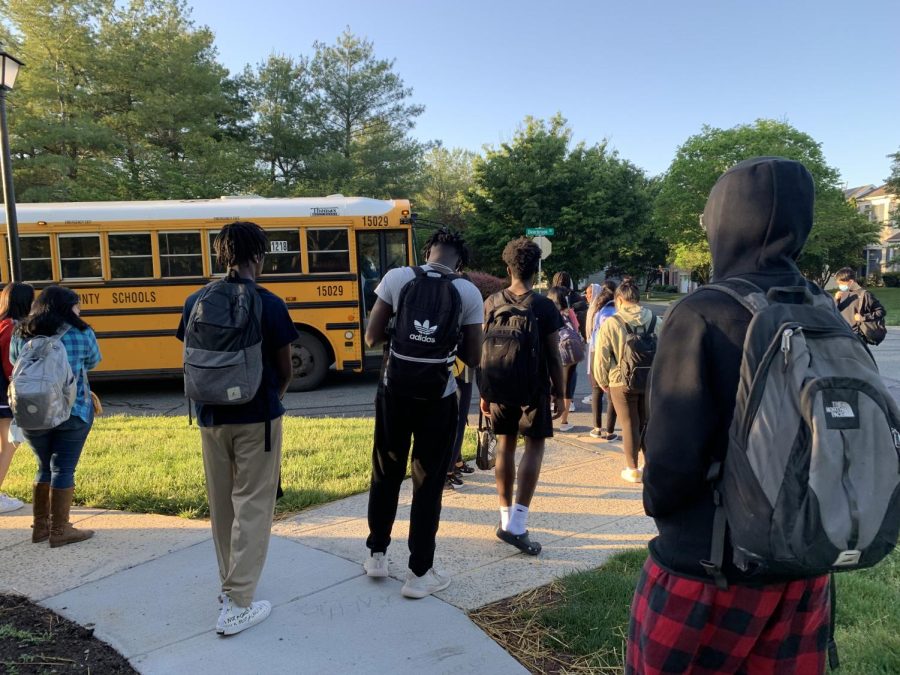Recent MCPS crashes rekindle need for action
There have been multiple collisions in MCPS in recent years, several fatal, where students were hit by vehicles while waiting for or getting off of their school buses.
June 9, 2022
$570. 54,458. 100,000. These numbers represent the Maryland fine for ignoring the red flashing lights on a stopped school bus, the number of citations issued by Montgomery County in the 2018-2019 school year to drivers who illegally passed school buses and the number of students in MCPS who ride a school bus daily, respectively.
However, being safe on the way to and from school is not guaranteed in MCPS. On April 5, 2022, a seven-year-old Ashburton Elementary School student died after being hit by a car while waiting for his bus near his stop in Bethesda. In December 2019, a 9-year-old Bradley Hills Elementary School student died after being hit by the school bus she had just exited. The morning after, a Walter Johnson High School student was seriously injured after being hit by a car while crossing the road to board his school bus. In October 2019, four John F. Kennedy High School students were injured, one with life-threatening injuries, at their bus stop after getting struck by a car.
These repeated collisions have led to legislative change. The Safe Walk to School Act was recently passed in the Maryland General Assembly after being introduced by Del. Jared Solomon of Montgomery County. Naming Montgomery County directly, the act calls for a pedestrian safety plan to be required in specific situations in terms of school expansions. There have been no crashes for WCHS students, but the same factors that caused the previous collisions are present at WCHS as well.
“When I go through the carpool line in the mornings [at Churchill], it’s very chaotic,” WCHS sophomore Julianna Ward said. “There’s an intersection that is just a mess – it looks like there are no rules sometimes.”
Problematic infrastructure is a significant cause of these crashes. For example, in the December 2019 Bradley Hills student’s fatal crash, there were no sidewalks on the road where the students were dropped off, which led to dangerous circumstances. Moreover, advocates note that many schools are not located in areas designed to be community-friendly.
“Traffic violence and specifically pedestrian safety is a problem that has to be addressed through a variety of mechanisms,” Brigid Howe, a member of the Board of Directors for the Montgomery County Council of Parent-Teacher Associations (MCCPTA) said. “If our community prioritized the safety of all roads, users…our roads would look different than they currently do. [Drivers need to] slow down… and be aware of their surroundings. City planners and traffic engineers could install bump outs and speed bumps, lower speed limits, add traffic lights, etc.”
The family of the WJ student from the December 2019 collision filed a lawsuit in March 2022 in the Montgomery County Circuit Court. The suit contends that the school bus driver had regularly neglected to deploy the bus’s flashing signals before reaching the crosswalk and that the driver of the car that hit the student had been driving recklessly. Additionally, it claims that the Montgomery County government had received multiple citizen complaints and police reports about pedestrian safety along that road in the years leading up to the crash, but nothing had been done. MCPS was also named as a defendant. In short, it highlights the question of who is most responsible for the crashes and who must assume the most responsibility for moving forward.
“There needs to be synergy between all of those responsible for roads and for the people using roads – so MCPS, the county, state and federal governments, road users, etc,” Howe said. “There are terrific advocacy groups in the county, including the Safe Routes to School committee of MCCPTA, Families for Safe Streets and Action Committee for Transit.”
The primary MCPS student pedestrian safety resource is Safe Routes to School (SRTS). Its two main goals are improving infrastructure along bus routes and educating students about the issue. However, most members of the MCPS community are not aware of its existence. Furthermore, important information such as the link to requesting a sidewalk, forms to report drivers who pass stopped buses and school bus safety guidelines for loading and unloading at the bus stop and during the bus ride are located at the bottom of the website, which likely significantly decreases its effectiveness. Local activists hope that more concrete action will be pushed forward.
“Concrete actions that MCPS can take [need] to be very intentional and thoughtful about safety while siting bus stops, develop new and rebuilt school sites to make them safely accessible by pedestrians and bus riders rather than prioritizing vehicular access, use their communications infrastructure to communicate about pedestrian safety resources and use their influence to advocate for sidewalks to be built on all streets within their walk zone,” Howe said.
In January 2020, following the two consecutive collisions, MCPS officials announced that they would be reviewing the locations of all stops. At the same time, County Councilmember Gabe Albornoz suggested working with companies that create navigation systems to implement user-oriented alert sensors on buses and Councilmember Craig Rice called for a mandatory pedestrian safety education campaign to raise awareness across the district.
However, following this brief stint in the spotlight, the county’s mainstream attention has largely shifted away, along with the council members’ initiatives. After the fatal April crash, the only responses by county officials were tweets by County Executive Marc Elrich and Montgomery County At-Large Councilmember Evan Glass. There have been no announcements for any further reactive actions.
Road safety activists highlight that student advocates and other community members can make routes safer without waiting for MCPS to pass official changes.
“[Members of the MCPS community] can pay attention as pedestrians and drivers,” Howe said.
“Advocate for sidewalks if there aren’t any on your street or in your community. Audit the bus stops in your community to check for safety, and if you feel a bus stop is unsafe, tell your principal.”
The number of people within MCPS who have tirelessly worked to improve pedestrian safety for students is not inconsiderable. However, the number of changes that have been made is disproportionate to the level of urgency with which these advocates are protesting. The bottom line: why do these largely preventable crashes keep happening? When is enough enough?
“Protecting the students is important,” Ward said. “It’s just for everyone. Students deserve to feel safe on their way to school.”



